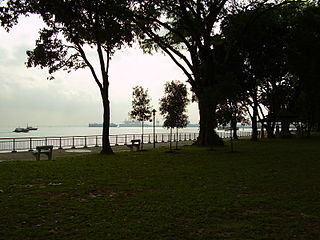
Sentosa Island, known mononymously as Sentosa, and formerly Pulau Blakang Mati, is an island located off the southern coast of Singapore's main island. The island is separated from the main island of Singapore by a channel of water, the Keppel Harbour, and is adjacent to Pulau Brani, a smaller island wedged between Sentosa and the main island.
The year 2004 in archaeology included many events, some of which are listed below.

Raffles Place MRT station is an underground Mass Rapid Transit (MRT) interchange station on the North South Line (NSL) and East West Line (EWL) in Singapore. Located in the Downtown Core, the station is underneath Raffles Place, the centre of Singapore's financial district, south of the Singapore River. The station serves various landmarks including Merlion Park and the Asian Civilisations Museum and various commercial buildings such as One Raffles Place and OCBC Centre.

Fort Siloso is a decommissioned coastal artillery battery in Sentosa, Singapore. It consists of 12 such batteries which made up "Fortress Singapore" at the start of World War II, and saw action during the Battle of Singapore. The fort is now a military museum open to the public. The Surrender Chambers in Fort Siloso reopened in June 2017 with a refreshed exhibition and free admission.

Raffles Place is the centre of the Financial District of Singapore and is located south of the mouth of the Singapore River. It was first planned and developed in the 1820s as Commercial Square to serve as the hub of the commercial zone of Singapore in Raffles Town Plan. It was renamed Raffles Place in 1858 and is now the site of a number of major banks. It is located in the Downtown Core within the Central Area, and features some of the tallest buildings and landmarks of the country.
National monuments of Singapore are sites, buildings and structures in Singapore that have been designated by the National Heritage Board (NHB) as being of special historic, traditional, archaeological, architectural or artistic value. For historical significance, these buildings are not allowed to be demolished. The Preservation of Monuments Act gives the board authority to order the preservation of such sites and promote research and public interest in the monuments.

Tanjong Pagar MRT station is an underground Mass Rapid Transit (MRT) station on the East West line located at Maxwell Road between the junctions of Peck Seah Street and Cecil Street in Downtown Core, Singapore. The station was built in the 1980s, and was opened in December 1987. Taking its name from Tanjong Pagar Road, which is located near the station, it is located near Tanjong Pagar Complex, the AXA Tower and International Plaza.

Fort Canning Hill, formerly Government Hill, Singapore Hill and Bukit Larangan, or simply known as Fort Canning, is a prominent hill, about 48 metres (157 ft) high, in the southeast portion of Singapore, within the Central Area that forms Singapore's central business district.
Archaeology in Singapore is a niche but growing discipline. Although there is generally a lack of government support for archeological work, many artifacts have been unearthed at sites around the island, helping to give a clearer picture of Singapore's history, both concerning the early history of Singapore and its subsequent colonial settlement following the founding of modern Singapore, the former being particularly useful in revealing archaeological evidence reflecting references to settlements such as Temasek, Ban Zu, Long Ya Men and the Kingdom of Singapura in chronicles and records.

A Famosa (Malay: Kota A Famosa; "The Famous" in Portuguese, also known as Fortaleza Velha Portuguese: the old fortress, and Dutch: Slavenburgh & De Misericorde was a Portuguese fortress built in Malacca, Malaysia, in 1512. The oldest part of the fortress was a five-storey keep which gave its name to the fortress as a whole. Some time following the Battle of Malacca and the occupation of the city by the Dutch, the keep was destroyed but the outer walls of the fortress were reinforced. However, in 1807 the British destroyed most of the fortress. The Porta de Santiago gateway, and the restored Middelburg Bastion, are the only parts of the fortress that remain today. They are among the oldest European architectural remains in Southeast Asia and the Far East.
The Canadian International School (CIS) is an international school in Singapore with a campus at Lakeside. CIS operates under International Baccalaureate Primary, Middle Years and Diploma programmes. The school accepts students from Nursery to Grade 12.

Labrador Nature Reserve, also known locally as Labrador Park, is located in the southern part of mainland Singapore. It is home to the only rocky sea-cliff on the mainland that is accessible to the public. Since 2002, 10 hectares of coastal secondary-type vegetation and its rocky shore have been gazetted as a nature reserve and its flora and fauna preserved by NParks.

Fort Pasir Panjang or Labrador Battery is located within the lush Labrador Park at the southern tip of Singapore island. It was one of the 11 coastal artillery forts built by the British in the 19th century to defend the western passageway into Keppel Harbour against piracy and foreign naval powers. During the 1942 Battle of Pasir Panjang, the fort played a supporting role but a limited one in defending the Malay Regiments against the Japanese invasion at Bukit Chandu. In 1995, the site was gazetted by the National Heritage Board as one of the 11 World War II sites in Singapore.

Tanjong Katong Primary School is a government primary school, located on Seraya Road in Tanjong Katong, under Marine Parade Planning Area in the East Region of Singapore.

The Johore Battery was a former British coastal artillery battery located in Changi on the easternmost side of mainland Singapore. It consisted of three large BL 15-inch Mk. I naval guns installed on land by the British government in the late 1930s to defend the approaching path to the east of the island to their large naval base located at Sembawang in the north from an attacking enemy naval force.

Katong Park MRT station is a future underground Mass Rapid Transit station on the Thomson–East Coast line situated at the boundary of the planning areas of Kallang and Marine Parade, Singapore. The station is located underneath the junction of Fort Road, Tanjong Rhu Road and Meyer Road and will serve the Katong Park.

Katong Park is neighborhood park located in Katong, Singapore at the junction of Meyer Road and Fort Road. Built in the 1930s above the buried remains of Fort Tanjong Katong, it was one of Singapore’s oldest parks with the first public bathing pagar and was highly popular with families during the weekends. After the coastal reclamation works in the 1970s, the park lost its sea frontage and declined greatly in popularity. It now remains as a small community park serving nearby residents.
The first fortifications of Singapore consisted of batteries built in the early 19th century to protect the harbour and city. After this there were two main phases of building.
John Norman Miksic is an American-born archaeologist.
Fort Serapong is a former coastal artillery battery on Mount Serapong hill on Sentosa Island in Singapore, then known as Pulau Blakang Mati. It was one of four major batteries on the island, along with Fort Siloso, Fort Connaught and the Mount Imbiah Battery.














